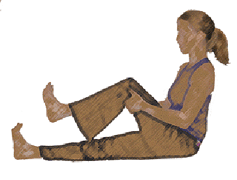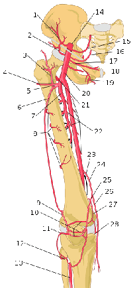By Bernie Clark, August 13th, 2014
 Pins and needles, or a burning sensation running down the leg, or just a bit of tingling in the fingers? Many meditators and yogis have had them too: should you be worried? What is causing these sensations, and what should you do about them? Certainly, the way we move and hold our body can cause these uncomfortable sensations, but there may be a more serious problem lurking that you will want to investigate further.
Pins and needles, or a burning sensation running down the leg, or just a bit of tingling in the fingers? Many meditators and yogis have had them too: should you be worried? What is causing these sensations, and what should you do about them? Certainly, the way we move and hold our body can cause these uncomfortable sensations, but there may be a more serious problem lurking that you will want to investigate further.
We can generalize the causes of tingling and numbness into two main categories: 1) those caused by a decrease in blood circulation (normally causing the pins & needles sensations), and 2) those caused by impingement of a nerve (normally manifesting as tingling or burning). The former often afflicts meditators: when we sit for meditation in one position for a long time without the normal fidgeting and moving around we do at other times when we sit, we can easily compress the femoral artery that feeds the legs and feet. Often you won’t notice that you have cut off the blood flow to your extremities until you try to come out of the meditation posture: then you will discover that your foot (or both feet) has fallen asleep. As the circulation returns, you will experience the typical pins and needles effect.
Tingling in the Lower Body
 Generally, we don’t sit in meditation so long that we risk gangrene setting in, but cutting off blood flow is not desirable. If you experience these sensations every time you sit in meditation, you may have been told that the sensations are part of the practice: notice them, but don’t react. That could be wise advice if there really is no way around the blood flow restriction, but before you submit to this condition, it is skillful to find a slightly different posture that won’t reduce blood flow. As shown in the graphic, the major leg artery runs inside the front of the pelvis (here it called the external iliac artery – see #14) and down the inside of the thigh (see #20: the femoral artery). As we sit, our pelvis is placed in flexion and this flexion can compress the top of the artery, thus restricting blood flow downstream. If this happens to you, experiment with different ways of flexing your pelvis: try having your legs abducted a little further apart, or try switching which foot you draw in first as you sit cross-legged. Sitting up on a higher cushion, or a bench may also reduce the amount of flexion and thus compression of the artery.
Generally, we don’t sit in meditation so long that we risk gangrene setting in, but cutting off blood flow is not desirable. If you experience these sensations every time you sit in meditation, you may have been told that the sensations are part of the practice: notice them, but don’t react. That could be wise advice if there really is no way around the blood flow restriction, but before you submit to this condition, it is skillful to find a slightly different posture that won’t reduce blood flow. As shown in the graphic, the major leg artery runs inside the front of the pelvis (here it called the external iliac artery – see #14) and down the inside of the thigh (see #20: the femoral artery). As we sit, our pelvis is placed in flexion and this flexion can compress the top of the artery, thus restricting blood flow downstream. If this happens to you, experiment with different ways of flexing your pelvis: try having your legs abducted a little further apart, or try switching which foot you draw in first as you sit cross-legged. Sitting up on a higher cushion, or a bench may also reduce the amount of flexion and thus compression of the artery.
The other main cause of numbness or tingling is compression of a nerve rather than an artery. The three major sites where this can arise in mediation or in yoga are:
- The buttocks
- The spine
- The shoulders
Let’s look again at tingling in the lower body: one of the most common causes is compression of the sciatic nerve. The places of impingement can either be in the lower back or deep in the buttocks. If the impingement of the sciatic nerve occurs deep in the muscles of the butt, this can be determined through a provocation test called FAIR (flexion, adduction, internal rotation): if flexing the hips, adducting the legs together and internally rotating the leg makes the pain worse, then the cause of your sciatica is likely compression of the nerve as it winds its way along the outside of the pelvis, underneath the big butt muscles. However, if the cause is discogenic, the FAIR provocation won’t make the situation worse. Here the cause is more likely impingement of the sciatic nerve by a bulging disc or some other abnormality located near the lumbar vertebra. (For a more detailed analysis of sciatica, view the article Sciatica & Yoga.) Once again, sitting up higher on a cushion may reduce these symptoms, which reduces the amount of flexion. Reducing the adduction of the legs or their internal rotation may also decrease the pressure on the nerve. Experiment with leg positions.
Tingling in the Upper Body
 Tingling in the fingers or hands can also be caused by either reducing blood flow to the arms or by compressing the nerves that innervate the arms and hands. This is sometimes referred to as thoracic outlet syndrome. We can see in this graphic that the key nerves and arteries supplying the arm run just under (deep to) the clavicle (aka: our collarbone.) The clavicle is firmly connected to the top of the scapula, and when we move one bone, we move the other. This means that when we raise the arm up overhead, causing the humerus to push against the scapula moving it backwards, the clavicle also moves deeper into the body. Depending upon the shape of your collarbone and the routing that your nerves and arteries take as they run into the arm, you may be likely to compress one or both: compressing either the brachial plexus, which is the bundle of nerves innervating the arm or the subclavian artery.
Tingling in the fingers or hands can also be caused by either reducing blood flow to the arms or by compressing the nerves that innervate the arms and hands. This is sometimes referred to as thoracic outlet syndrome. We can see in this graphic that the key nerves and arteries supplying the arm run just under (deep to) the clavicle (aka: our collarbone.) The clavicle is firmly connected to the top of the scapula, and when we move one bone, we move the other. This means that when we raise the arm up overhead, causing the humerus to push against the scapula moving it backwards, the clavicle also moves deeper into the body. Depending upon the shape of your collarbone and the routing that your nerves and arteries take as they run into the arm, you may be likely to compress one or both: compressing either the brachial plexus, which is the bundle of nerves innervating the arm or the subclavian artery.
Notice the wide range of shapes of various clavicles shown below [1]: we are all different and the reality of human variation means that some people are more prone to compressing their subclavian artery or brachial plexus than others. The last two clavicles on the right are much more likely to press against the nerves and arteries than those on the left. The routing of the arteries and nerves also vary which may make the situation better or much worse.
Whenever we bring the arms up and back, or draw them out wide to the side, the potential exists for compression of the arteries or impinging the nerves. Many people will never experience this, but many others easily feel the tingling in their fingers when they move their arms out or up. If you fall in this latter camp, it is wise to avoid movements that create the tingling sensation: if you persist and choose to ignore the sensation you may permanently damage the nerves, with dire consequences! There have been yogis who aggressively worked to open their chest and tops of the shoulders in order to drop back from standing into the Wheel pose (urdvadhanursasana), but along the way, damaged their brachial plexus to the point where they lost the use of their arms. Fortunately, in the one case I am familiar with, the condition was only temporary and after one month of healing, all was well again, but a valuable lesson was learned! Do not ignore tingling sensations.
If you are subject to tingling in your fingers – notice when it happens. Sometimes the sensations will be deferred until the next day: if so – try to recall what you were doing in the previous 24 hours that may have contributed to your present tingling or numbness. The solution may be as simple as not going to your full range of motion: if you feel tingling in a reclining twist when your arm is extended out to the side or overhead, lower your arm or rest it on a bolster. Find the position where there is no tingling.
We have been looking at only two primary causes of tingling or numbness, those that often can arise in a yoga or meditation practice. However, there are many possible causes of tingling and several of these suggest deeper medical investigations. Infections like herpes and shingles can cause similar sensations. Dietary deficiencies such as a lack of vitamin E, B1 of B12 or too much B6 can be a cause. Alcohol abuse, Diabetes, Multiple Sclerosis, Migraines or certain medications can be a cause. Animal bites or nerve damage might be the cause. It would be wise to check with your health care provider if you experience any of the following symptoms or conditions:
- Numbness or tingling has no obvious cause – unrelated to your yoga or meditation practice
- You have pain in your neck, forearm, or fingers
- You are urinating more often
- Numbness or tingling in your legs that gets worse when you walk
- You have an unexplained rash
- You have dizziness, muscle spasm, or other unusual symptoms
Numbness that comes on suddenly and is accompanied by weakness which has no apparent cause or that does not improve quickly could very well be an emergency, such as a stroke. This should be checked out by a medical professional as soon as possible.
Despite all these dire causes, the most common cause of tingling or numbness, fortunately, is not moving for a long period of time. The cause: compression of a nerve or an artery. The solution: move! Pay attention to what you are feeling and if the sensations are tingling, numbness, pins and needles or burning, adjust your posture and find a place where these sensations don’t arise.
The worst thing to do about tingling is to ignore it. If you have tingling, find out why and change what you are doing. Practice with attention and intention.
Footnotes:
- — Thanks to Paul Grilley for making these images freely available. You can find the original pictures at his web site
